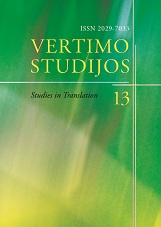Latvian Translation Scene at the Turn of the 19th and 20th Century
Latvian Translation Scene at the Turn of the 19th and 20th Century
Author(s): Andrejs VeisbergsSubject(s): Recent History (1900 till today), 19th Century, Translation Studies
Published by: Vilniaus Universiteto Leidykla
Keywords: censorship; literary translation; Latvian translators; fidelity; free translation; periodicals;
Summary/Abstract: The paper looks at the Latvian translation scene at the end of the 19th and the beginning of the 20th century. It is a continuation of the study of translation history in Latvia reflected in previous issues of Vertimo studijos (vol. 7, 8, 11). These decades are marked by a huge growth of translation, especially in periodicals. German was gradually losing its dominant position as a source and intermediate language, Russian was advancing, so was also the scope of other languages. In contrast to previous periods there was a particular interest in the quality of the originals and modernity. This period also saw a change of generations among translators, and women became visible in translation scene. Translators among whom there were all the great Latvian writers gradually emerged as professionals. Frequently translations had prefaces and explanations by the translators. There were numerous parallel translations of the same works, some reaching up to ten versions. Translations included various genres and the traditional Latvian interest in plays was very obvious. So was the focus on specialised literature on agriculture. The translation method changed from localisation to a fidelity mode with a tendency to apply elements of foreignisation.
Journal: Vertimo studijos
- Issue Year: 13/2020
- Issue No: 13
- Page Range: 110-127
- Page Count: 18
- Language: English

